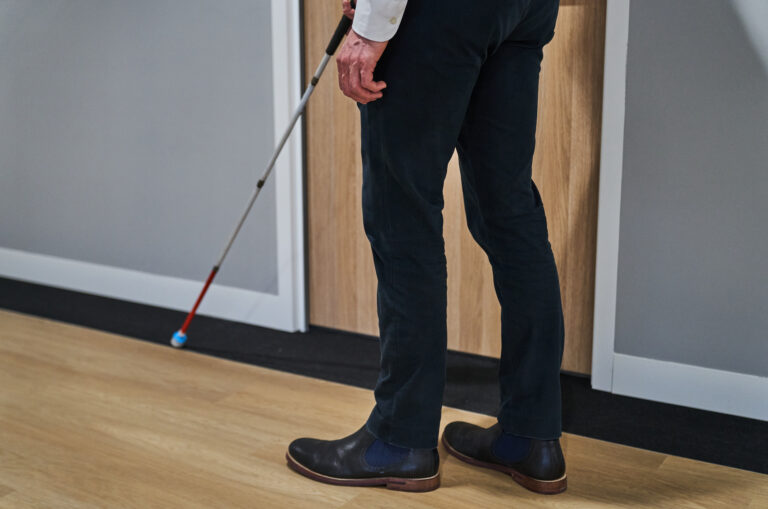What is a white cane?
A white cane is a traditional mobility tool used by many people with low vision or blindness around the world. It can be a vital tool for people with low vision or blindness to navigate public spaces, giving them the ability to get around safely and independently. Typically made from lightweight materials like aluminium or carbon fibre, its white colour is important for a couple of reasons. Not only does it make the cane easy to spot, but it also lets others know that the person using it has a visual impairment, which can help them navigate congested areas more easily.
The cane is swept back and forth in front of the person using it to feel what’s ahead. Whether it’s a curb, a step or any other kind of obstacle, the cane helps them sense changes in the ground, like bumps or gaps, that are well ahead of their next step, making it easier to move through unfamiliar areas. It can also help them identify common features along a route they take every day.
The white cane has always been a symbol of independence, but recent innovations in its design have sought to make it even more effective and easier to use.
Emerging white cane technologies
Smart canes
While traditional canes continue to help those with low vision or blindness, people continue to try to innovate, with the introduction of smart canes giving people more choice.
Some small additions can make a big difference. Built-in flashlights are especially useful for low-light conditions, while rain-resistant technology has also become more common, protecting smart canes in various weather conditions. But it’s what is inside smart canes where things are getting interesting.
One of the most notable innovations is obstacle detection technology, where canes equipped with sensors can detect objects above waist level, an area that traditional canes can’t reach. Sensors alert the cane’s user through sound or vibrations, with the intensity of the signal increasing as they get closer to the obstacle.
The latest smart canes go even further, integrating artificial intelligence and GPS technology. Some models now pair with an app so people can save and explore locations either through their phone or through the cane. The cane or app alerts them to the distance to their destination, giving them spoken directions via the cane’s speaker. Some people may be fine with this feature, while others might want to avoid drawing attention to themselves with a device that makes audible announcements.
But what if you could have a conversation with your cane? Smart canes can now feature Large Language Models (LLMs) connectivity, such as ChatGPT. This allows people to ask the cane questions and interact with it as they would with a smartphone, helping them do more than just navigate and explore spaces.
Of course, this type of tech isn’t for everyone.
One of the most important original features of the traditional cane is its provision of haptic feedback, or in other words the vibrations that the tactile feedback provides between the tip and surfaces. Some people prefer this organic interaction and a lightweight cane, rather than relying too heavily on electronic devices like obstacle detection.
It’s also important to consider the typically short life of a traditional white cane. Being such a tactile instrument, white canes experience wear and tear and require replacement. The risk of investing in smart cane technology might come down to needing to replace it too soon, so it’s important to consider how replaceable different elements of the cane might be.
Lightweight and adjustable materials
Any changes to the weight of a white cane put off many people, as over time this can add significant stress to wrist joints and fingers.
But the materials used in modern white canes have seen significant advancements. Today, manufacturers are using lightweight and adjustable materials such as carbon fibre and titanium, making the canes both sturdier and more comfortable, while some of the leaders in smart cane technology continue to improve the weight and handle design of their canes.
Different tip types
Perhaps the most simple but helpful advance in white cane technology is the breadth of choice people have in their tip design.
The type of white cane tip people opt for varies a lot. To avoid their tip getting caught on an object, which can be jarring and even painful, some opt for a rotating ball tip. Other tips are designed for outdoor use in bushland or grassland, while others are designed to optimise the auditory aspect of using a white cane.
Some tips can make the white cane heavier, which can impact wrist and arm movement. It’s important to choose a white cane tip based on how you want to use it, but also consider how it will impact the weight of the cane.
Object detection
There are other helpful devices you can use to detect objects, especially when you’re in a familiar environment like the office and you don’t want to use your cane.
One of the most common examples is the Miniguide. These are lightweight, handheld devices that can help people navigate their immediate environment, such as doorways, parked cars, and overhanging branches. This is similar to the technology that has been introduced into smart white canes, but you can keep it in your pocket when you’re not using it!
Learning how to use a white cane
The Orientation and Mobility service offered by Guide Dogs helps people with low vision or blindness learn how to move around safely and independently by using any remaining functional vision and other senses along with appropriate aides like mobility canes.
Orientation and Mobility Specialists work with individuals and their support people to teach many skills, including the ones necessary for making the most of a mobility cane. They work closely with individuals to teach them how to use white canes effectively, helping them adapt to different tip types and understand how to incorporate technology into their daily routines.
Read more about canes
Ready to continue?
Seems like you have filled this form earlier. Let’s pick up where you left off.









